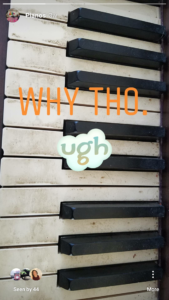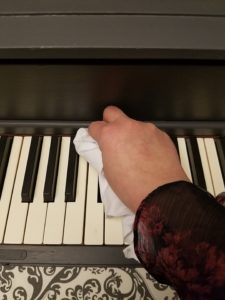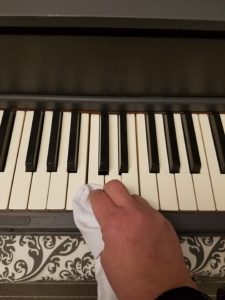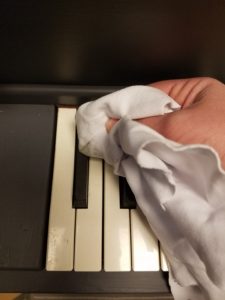Piano keys get really dirty.
Imagine your child sitting down at the piano to play and they just finished eating dinner. Did they wash their hands? Multiply this times a kazillion and you’ve got some filthy keys. Then, add to it that dust settles on top of the keys and also falls down the sides. Cleaning the keys is really simple, but lots of piano owners don’t do it. Why? I think it boils down to not knowing how to safely clean and dust the keys. Getting to know your instrument, helps to better take care of it.

When I say keys, I mean key tops.
When cleaning the keys, I’m really talking about just cleaning the tops of them. Cleaning the sides and back (inside) is a job for your tuner.
There are two reasons to regularly clean the keys.
First, keys get dirty. Fingers play on keys. Fingers therefore get dirty and pass these germs to others and themselves. This is especially true for young students who practice and have not gotten the hang of hand washing, not putting fingers in their mouths, picking their nose (come on, you know your kids do it too), and the like. Second, dust and grime that acculumates on the key tops falls down the sides of the keys and eventually ends up underneath. Once underneath, this can create issues with how well the piano plays and functions.
Cleaning the keys.
- Use a clean, non-lint cloth.
- Get yourself a cleaning spray WITHOUT BLEACH. This is important because not all key tops are white. Some are cream, off white, or real ivory and bleach will discolor the keys.
- Spray a small amount onto the cloth. DO NOT spray directly on the keys. You want enough cleaner to get the gunk off, but not enough to saturate or drip on the keys.
- Then, wipe from back to front. This way you are not pushing any of the dust or dirt back into the piano behind the fallboard. Note: the fallboard is the piece that opens and closes over the keys.
- A little note about the black keys: Be sure to know whether your black keys are plastic or wood. If they are wood, certain cleaners may remove some of the black. Do a tiny test spot on the lowest or highest black key to make sure it doesn’t remove any of the color. If the keys are plastic, there won’t be any issue. If they are wood, the safest thing is to use warm soapy water instead of a traditional cleaning agent. Putting the liquid on the cloth and not directly on the keys still applies.



As always, if you have any questions, please reach out! Comment on this post with your questions, or email thepianogalshop@yahoo.com. And don’t forget to check out the webstore too!
Musically,
Marta
The Piano Gal
